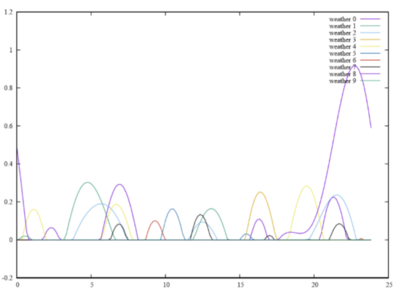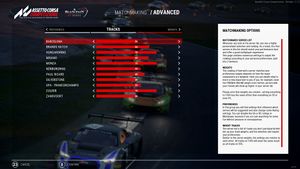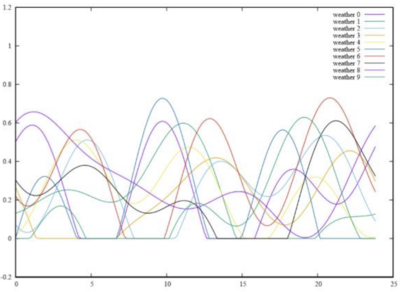Difference between revisions of "Multiplayer Overview/de"
DiRTyDRiVER (talk | contribs) (Created page with "Das umfassende Wettersystem startet am Freitagabend und entwickelt sich um die Basiswerte von Wolken, Regen und Temperaturen. Der Zeitmultiplikator ( ”timeMultiplier”: ) i...") |
DiRTyDRiVER (talk | contribs) (Created page with "Das Wetter führt zu Temperaturen, Sonneneinstrahlung, Wind und Wolken, die zu Regen führen können. Ein niedriger “weatherRandomness”-Wert ermöglicht eine realistische...") |
||
| Line 48: | Line 48: | ||
Das umfassende Wettersystem startet am Freitagabend und entwickelt sich um die Basiswerte von Wolken, Regen und Temperaturen. Der Zeitmultiplikator ( ”timeMultiplier”: ) in einer Sitzung beschleunigt auch die Rate der Wetterveränderungen. | Das umfassende Wettersystem startet am Freitagabend und entwickelt sich um die Basiswerte von Wolken, Regen und Temperaturen. Der Zeitmultiplikator ( ”timeMultiplier”: ) in einer Sitzung beschleunigt auch die Rate der Wetterveränderungen. | ||
| − | + | Das Wetter führt zu Temperaturen, Sonneneinstrahlung, Wind und Wolken, die zu Regen führen können. Ein niedriger “weatherRandomness”-Wert ermöglicht eine realistische Entwicklung eines Tagesablaufs. Eine Simulation von 10 verschiedenen Tagen mit einem Wert von 2 könnte zu solchen Regenfällen führen: | |
[[File:Weather simulation 1.png|400px]]Figure 1:example calculation of 10 days with low/medium randomness; y = rain %, x = hour of day | [[File:Weather simulation 1.png|400px]]Figure 1:example calculation of 10 days with low/medium randomness; y = rain %, x = hour of day | ||
Revision as of 18:48, 8 November 2019
Die 3 Server-Varianten
Der ACC Multiplayer ist in drei Bereiche unterteilt. Serveradministratoren können benutzerdefinierte Server für die ersten beiden Teile konfigurieren und ausführen.
| Varianten | Beschreibung |
|---|---|
| Öffentliche Multiplayer Server | ACC-Fahrer können auf öffentliche MP-Server zugreifen, indem Sie die große Schaltfläche "Quickjoin" bestätigen oder einen Server in der "Serverliste" auswählen. Diese Server verfügen nur über eine begrenzte Anzahl von Optionen. |
| Privater Multiplayer-Server | Wenn ein Server mit einem Kennwort "password": "accessPw123", geschützt ist oder sich nicht in der Lobby registriert "registerToLobby": 0, , wird er als privater Server betrachtet. Damit können komplexere Einstellungen vorgenommen werden. Grund dafür ist, das Serverbetreiber und Ligen-Veranstalter ihren Mitgliedern mitteilen können, welche spezifischen Einstellungen sie auf ihren Servern vorgenommen haben.
Private Server müssen in der Serverliste gesucht werden. Sie werden nicht mit den anderen Servern aufgelistet. |
| Wettkampf Server | Bis das endgültige Konzept für die CP-Server festgelegt ist, werden sie nur von Kunos ausgeführt. |
Matchmaking in ACC
Gehen Sie im spiel im Hauptmenü Auf die Schaltfläche "Multiplayer":
- automatischer Serverbeitritt:
- Legen Sie unter "Matchmaking-Optionen" Ihre Einstellungen fest und klicken Sie auf "Zurück"
- Klicken Sie dann auf das große Feld "Quickjoin" und Sie werden sofort auf einem öffentlichen Server angemeldet
- manueller Serverbeitritt:
- gehe zu "Serverliste"
- Legen Sie Ihre Einstellungen unter "Erweitert" fest und klicken Sie auf "Zurück"
- Wählen Sie einen Server
- Klicken Sie, um beizutreten
Was wird simuliert ?
Lesen Sie diese Informationen, bevor Sie einen Server erstellen.
Rennwochenende
Jeder Server-Zyklus (Training bis Rennen) simuliert ein ganzes Rennwochenende. Simuliert wird das Wetter, die Strecken-Bedingungen einschließlich des Verkehrsaufkommens im Rahmenprogramm. Bei aktivem dynamischen Wetter bedeutet dies, dass jedes Wochenende einzigartig und unvorhersehbar ist. Während die Konfiguration-Parameter bestimmen, wie plausibel, subtil oder verrückt sich das Wochenende anfühlt.
Wetter
Das umfassende Wettersystem startet am Freitagabend und entwickelt sich um die Basiswerte von Wolken, Regen und Temperaturen. Der Zeitmultiplikator ( ”timeMultiplier”: ) in einer Sitzung beschleunigt auch die Rate der Wetterveränderungen.
Das Wetter führt zu Temperaturen, Sonneneinstrahlung, Wind und Wolken, die zu Regen führen können. Ein niedriger “weatherRandomness”-Wert ermöglicht eine realistische Entwicklung eines Tagesablaufs. Eine Simulation von 10 verschiedenen Tagen mit einem Wert von 2 könnte zu solchen Regenfällen führen:
 Figure 1:example calculation of 10 days with low/medium randomness; y = rain %, x = hour of day
Figure 1:example calculation of 10 days with low/medium randomness; y = rain %, x = hour of day
You see most of the days have some rain mixed in but are dry in most of the time. That means the chance to witness rain during a 20-minute session is low but can happen. Extending the time by either longer sessions or higher time multipliers will raise the chance.
Also note that most rain showers are in the “light/medium rain” region, only one day delivered a full thunderstorm. This is where the baseline of both “cloudLevel” and “rain” play an important role; raising either will make rain more probable.
Raising the “weatherRandomness” towards the upper end causes more extreme scenarios, where the weather is changing a lot often per day, and is allowed to leave the baseline values more easily. A more extreme case would be around values 5 or 6:
It’s clear how both frequencies and amplitudes change. While this looks nice and sensational, we do not recommend to use extreme values. Even if there is no rain, a value of 2 will already notably shift around clouds, temperatures and wind – but in a way you can still understand what is going on while sitting in a race car. If the temperatures for example raise and drop by 5°C within minutes, most users will constantly have the feeling that something is wrong and they don’t understand what it is.
So please feel free to experiment with those values and create a cool server setup, but keep in mind that it doesn’t have to reliably rain and stop twice within a 20 minute race session, and that users have to have a chance to follow the weather development.
Track
During a Blancpain race weekend, many different things are going to influence the track conditions. Friday night, we will start with fairly low or no rubber line, and a dusty track in general. Once the support programs start to run, the track will get a bit cleaner and build up rubber. How your first session looks like strongly depends on the race day you set up – Friday morning before 10am will give you the virgin track, while Saturday evening is already quite good grip. If it didn’t rain in between of course; high weather variation will of course often wash out the track. But as we also simulate the traffic of the other series during the weekend, you may find yourself in wet track with low/no rain, and the dry line started to form. Or the opposite, your session may find a really rubbered ideal line while it just starts to rain (beware, highly slippery).
Unlike the weather, the track is not affected by the time multiplier, and always “runs” in real time. That means even if you have a quick thunderstorm for one minute, your track won’t immediately rush to full wetness levels, and it also will dry out in real time. The water dissipation rate depends on sun angle, cloud level, temperatures and wind. That means a hot, sunny mid-day scenario may clean up the track within minutes, while you can still find the track wet and full of puddles after a cold night (no sun) or cloudy hours.
Again, having realistic and plausible weather settings will help users to understand what is going on based on their every-day experience, which in the end makes their experience better – be careful with extreme weather settings and time multipliers. It is also recommended to think about the real track observations; Locations like Spa or Nürburgring tend to have unlimited amounts of surprises, while Barcelona is known to be quite stable and hot (I’ll deliberately leave out the Italian tracks here, after having visited them in 2018 and 2019).
In a recap, we exposed very few parameters to a quite complex system, and playing with those will vastly influence the experience on your server. It is worth to learn and experiment with those settings!
Server Configuration
You have the option to run a server on your PC (LAN) or rent one from providers of Dedicated Servers. See here: Server Configuration.

